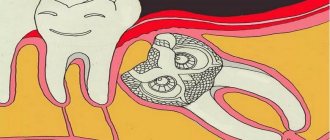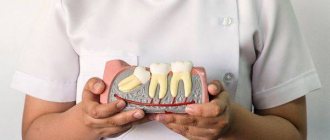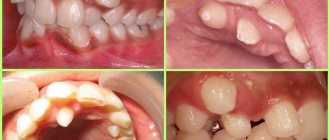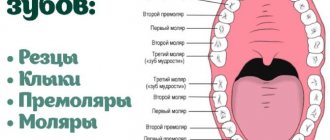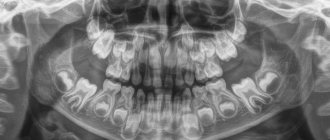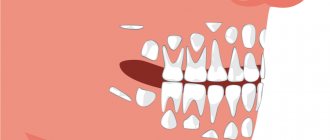Polyodontia (hyperodontia, hyperdentia) is the appearance of supernumerary teeth. Normally, an adult has 28-32 teeth (including wisdom teeth); with polyodontia, an indefinite number of extra teeth appear. About 2% of the world's population suffers from the pathology.
There are no methods to prevent the development of polyodontia, but it is possible to reduce the number of complications caused by the disease. Therefore, it is necessary to be attentive to your health and undergo a preventive examination with a dentist twice a year. If you suspect that an extra tooth has appeared in your mouth, you should immediately consult a doctor. Particular responsibility lies with parents, since children are not able to independently monitor the health of their teeth.
Causes of the disease
The causes of polyodontia have not yet been established; there are three hypotheses for the occurrence of the anomaly:
- Atavism. The concept of atavism means the appearance in a person of any signs characteristic of his distant ancestors, but absent in his closest relatives. Proponents of this theory explain supernumerary teeth as an accidental return to the past, when human ancestors had six incisors on each jaw. This version is confirmed by the frequent occurrence of polyodontia in the frontal area of the jaws.
The disadvantage of this assumption is that it explains the appearance of extra teeth near the incisors and canines, but does not explain the reasons for the presence of supernumerary molars and premolars.
- Splitting of the tooth germ. The reason for polyodontia, according to this theory, is disturbances that occur during embryonic development at the stage of formation of tooth buds (the appearance of the buds of permanent teeth occurs in the 10th week of the prenatal period).
The theory explains the occurrence of hyperdontia in various parts of the dentofacial apparatus, but is not able to explain why one person can simultaneously develop congenital hypodontia with an increased number of teeth - their absence associated with underdevelopment of tooth germs.
- Proponents of the third hypothesis combine the previous two, considering supernumerary teeth to be a combination of genetic anomalies and features of embryonic development.
According to statistics, the number of cases of polyodontia is currently increasing; scientists associate this with an increase in the level of ionizing radiation, which leads to mutational changes in the body. Polyodontia of permanent teeth is much more common than supernumerary teeth.
Types of supernumerary teeth
Extra complex teeth can have several edges, be cone-shaped or have other shapes. In rare cases, they have the correct tooth shape.
According to the shape of the crowns, teeth are:
- spinous - the crown has the shape of a sharp cone;
- chisel-shaped - the crowns of the teeth are flattened;
- tuberculate - the crown is covered with tubercles and pits;
- fused - supernumerary teeth are connected to complete teeth in the root, crown part or throughout.
If supernumerary teeth have a well-developed root and formed periodontium, then they erupt very intensively. Extra teeth are located both in the dental arch and outside the dentition; they often disturb the arrangement of complete teeth. Supernumerary teeth appear simultaneously with permanent teeth, or slowly, one after another.
There is such a type of polyodontia as false, or pseudopolyodontia - when an adult retains milk teeth after the appearance of permanent teeth. There are known cases of detection of baby teeth in patients aged 50-60 years.
Timing of growth of wisdom teeth
The process of changing the bite from milk to permanent is usually completed by 12–13 years. Wisdom teeth erupt later, already in adulthood - hence the telling name. You can expect the appearance of third molars from the age of 17 - 18, although there have been cases when one or more wisdom teeth erupted both at 13 - 15 and at 35 - 40 years. The average period of appearance is limited to the interval between 20 and 27 years. If after 30 years not a single wisdom tooth has erupted, most likely this will never happen again.
Impacted supernumerary teeth
Often, supernumerary teeth stop growing and remain impacted, that is, unerupted. Such teeth may not appear for a long time; they are discovered by chance during an X-ray examination of the oral cavity. The presence of an impacted supernumerary tooth may be indicated by the following symptoms:
- The appearance of mobility of complete teeth;
- periodic aching pain in the area where the tooth is located;
- tissue compaction if the tooth is located close to the edge of the jaw.
Cysts sometimes develop on the root of the tooth, which may not cause pain for some time; they are also detected during x-ray examination.
Diagnostics
An erupted supernumerary tooth is detected during examination of the oral cavity; it is often dystopic, that is, abnormally located.
Diagnosis of unerupted (impacted) supernumerary teeth is carried out using x-ray examination. Often, X-ray diagnostics of supernumerary teeth is difficult due to the fact that in the image their contours overlap the contours of the complete teeth. For more accurate diagnosis, 3D computed tomography is used. The results of these studies make it possible to obtain comprehensive information about the relative position of erupted and impacted complete and supernumerary teeth.
Complications caused by polyodontia
Supernumerary teeth appear more often on the upper jaw in the permanent dentition, and are less common on the lower jaw and in the primary dentition. Their appearance threatens with the following complications:
- Development of anomalies of the dental system: change in the position of complete teeth: their displacement to the sides, forward or backward, rotation around an axis;
- bite deformation, as a result – disruption of chewing and speech functions;
- disruption of the eruption of permanent teeth, up to the loss of their ability to erupt;
- the appearance of a diastema - a pathological distance between the central incisors;
- the formation of three spaces between the remaining teeth.
- chronic gingivitis;
The eruption of supernumerary teeth is often accompanied by the following symptoms:
- increased body temperature;
- pain and swelling in the eruption area;
- increased salivation;
- swelling of the nasal mucosa.
Supernumerary teeth affect not only the visual component of the smile, but also cause systemic disorders that lead to deterioration in chewing food and disruption of the stability of the main teeth. All this also affects a person’s psychological comfort: he becomes withdrawn, does not smile, so as not to demonstrate smile defects.
Can wisdom teeth be completely missing?
Missing wisdom teeth is quite normal. About 20 - 25% of people alive today do not have erupted eighth molars at all. “Eights” are considered a vestige, although our ancestors, who lived a couple of tens of thousands of years ago, had 36 or more teeth. This is explained by the structure of the jaw and diet. Ancient people had a more massive jaw and were forced to eat rough, unprocessed food. Twenty-eight teeth are enough for a modern person: the absence of additional molars does not in any way affect the functionality of the dental system and eliminates complications that arise from improper eruption.
Treatment
Relief of teething symptoms
Teething may be accompanied by the usual symptoms for this process: pain, itching, swelling of soft tissues, and sometimes fever; Children are especially sensitive to the teething process. To relieve symptoms use:
- Nonsteroidal anti-inflammatory drugs: paracetamol, ibuprofen. They are taken orally to reduce fever and reduce inflammation.
- Products for topical use: gels Dentol, Dentinox-N, Kamistad. The products are applied to the teething area and have analgesic and anti-inflammatory effects.
- From the age of three, rinsing with propolis tincture is allowed: 15 ml of tincture is diluted in 100 ml of warm boiled water, rinse the mouth up to five times a day.
- It is advisable to consult a doctor.
Tooth extraction
As a rule, the treatment of polyodontia consists of the removal of supernumerary teeth, which is carried out under local or general anesthesia. Extraction of an erupted, evenly positioned supernumerary tooth is usually not difficult; removal of impacted teeth is difficult. In this case, the surgeon makes an incision in the soft tissue to access the tooth, then saws it out of the bone tissue, completely removing it. After this, biomaterial is placed into the hole to restore bone tissue, and the wound is sutured.
Removal of a supernumerary tooth can be complicated by the proximity of its roots to the roots of permanent teeth, the large depth of the tooth and the irregular shape of the tooth being removed. Data from studies conducted using computed tomography provide great assistance in choosing a removal technique and making a treatment prognosis.
To avoid serious disorders of the dental system, it is advisable to visit an orthodontist. And children are recommended to have a consultation for prevention from the age of 3.
Sometimes, in order to prevent injury to the tooth germs of adjacent teeth, it is necessary to delay the removal of supernumerary teeth until they have fully or partially erupted. A delay is indicated if the extra teeth, when erupting, do not cause changes or deformations in the jaw bone.
It happens that supernumerary teeth have a normal shape and a well-developed healthy root, while the permanent tooth is damaged, incorrectly positioned or susceptible to retention (delayed eruption). If an X-ray examination confirms the futility of a complete tooth, it is removed, leaving the supernumerary one.
Orthodontic treatment
This type of treatment is usually required for children and adults with existing pathology to restore normal jaw development and correct the bite. Also, the help of an orthodontist will be required to place a supernumerary tooth into the dentition if a decision was made to replace a complete tooth that was removed for some reason.
To correct any abnormalities, braces are used, which the doctor selects individually for each patient. The braces system consists of locks that are attached to the teeth and connected to each other by a metal arch that maintains a given shape. While wearing an orthodontic device, under the influence of the arc force, the teeth take the correct position, the smile becomes even and beautiful. Dental plates are made for children at a young age. The sooner the problem is identified and measures taken, the faster the solution will be.
Why don't wisdom teeth grow in adults?
The rudiments of “eights”, as a rule, are formed at about three years. Wisdom teeth finally mature around 16–17 years of age. First, the crown part is formed, after which the roots can develop for several more years, even when the tooth itself has already erupted. The structure of a wisdom tooth is slightly different from other molars. Typically, figure eights have a larger number of root canals, often significantly curved. Wise teeth may erupt or remain in the jawbone. Below are the reasons for the lack of eruption of the eighth molars.
- Jaw size. A short jaw often does not give wisdom teeth enough space for normal growth, and they remain forever “buried” in bone tissue.
- Difficulty cutting. “Eights” do not have milk precursors, so it is quite difficult for them to break through bone tissue. Over the years, the jawbone becomes denser, which further complicates the emergence of wisdom teeth, which often occurs with pain, inflammation and discomfort. The period of eruption can take from several weeks to two years, so sometimes you just have to be patient.
- Incorrect position of teeth. In conditions of limited space, wisdom teeth are often located in the bone at an angle, resting their crowns on their neighbors, thereby shifting the dentition. In this case, the “eights” often do not erupt. At the same time, they can cause crowding and malocclusion, so they are usually removed. If the problem is not solved in time, neighboring teeth may suffer from such a dangerous proximity.
- Absence of rudiments. It often happens that a wisdom tooth is completely absent, that is, even its rudiments are not observed. This can be caused by a number of factors: heredity, jaw structure, race, area of residence, and so on. A complete absence of primordia is observed in approximately 5% of cases and this is considered normal.
